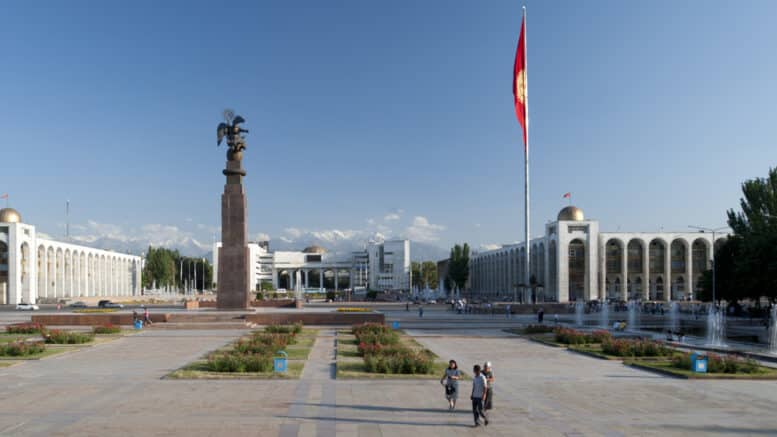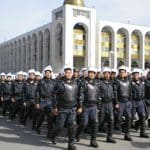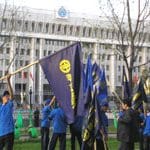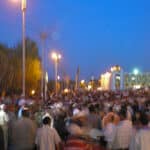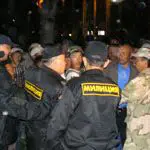Bishkek entered its ninth straight day of protests on April 19 with the promise by opposition leaders to dramatically increase the number of demonstrators in the capital. The political opposition groups that began their “unending” protest on April 11 in Bishkek’s center, on Ala-Too square, gathered with various demands: some called for President Kurmanbek Bakiyev’s resignation and early elections; others sought constitutional reforms to rebalance the branches of government; and many sought intensified efforts to combat corruption and implement improved social services.
However, few expected that Former Prime Minister Felix Kulov, now leading the opposition group United Front, and other politicians that had thrown their weight behind the For Reforms movement,could deliver a promised 100,000 demonstrators. Turnout on April 11th had proven disappointing for organizers hoping to match or exceed last November’s approximately 15,000 protesters.
of the Protests
Following an initial turnout of about 8,000 on April 11, the number of demonstrators in the center of Bishkek quickly dwindled. After a week, opposition leaders could reliably count on just some 2,500 or 3,000 demonstrators. The inability of opposition leaders to rally large numbers of people led some to believe a quick compromise could be reached between the administration and the opposition.
President Bakiyev had already shown willingness to compromise with the opposition, as seen in the March 30 appointment of opposition leader Almazbek Atambaev to the post of Prime Minister. However, this concession failed to bring about hoped-for negotiations and agreements. In large part this could be attributed to internal rivalries among the various opposition factions.
Moderates have sought a return of the November constitution. This document improved the balance of power between executive and legislative branches, strengthening the prime minister at the expense of the president. The power to appoint some ministers and direct certain security forces was transferred to the prime minister following a constitutional compromise that ended demonstrations last November. These changes were undone days later by deputies in the Zhogorku Kenesh (parliament) loyal to Bakiyev.
Kulov has demanded Bakiyev’s abdication and early elections. This more extreme stance was seen by some as an effort to rescue declining political fortunes. When Kulov served as prime minster alongside President Bakiyev, the two were known as the “tandem.” They represented a coalition government that united the historically rivalrous northern and southern sections of Kyrgyzstan. However, he resigned in December 2007, just as deputies undid the constitutional changes of November.
Even without the opposition’s factionalism, the possibility of either a constitutional compromise or early elections was cut short when opposition leaders lost control of their supporters early in the evening, April 19. Several thousand demonstrators, many of them drunk, massed in front of the White House to hear opposition speeches. After the opposition heads departed, their supporters remained behind, growing more raucous by the hour. The increase in protestors seen on this day was likely due to injections of protestors paid by opposition organizers to attend. Payment often occurs with cash or vodka. The administration also has a history of paying protestors or even provocateurs to attend and disrupt the demonstrations.
In response to the numbers and growing chaos of the gathered crowd, Bolotbek Nogoibayev, the Minister of Internal Affairs, deployed more than 3,000 police and security forces across the city with perhaps as many as 1,000 concentrated around the city center and White House. National Guard troops and sniper teams located on the White House grounds were also activated, but they never played a role dispersing crowds on Bishkek’s streets.
Deciphering whether government provocateurs or opposition members initiated the confrontation with security forces on April 19 is, and will remain, a difficult question, but identifying the flashpoint for violence is a much simpler task. Kyrgyz security forces numbering in the hundreds maintained strict discipline despite a flood of taunts, objects thrown at them and hounding photographers. But, when Nogoibayev – wearing no body armor and protected by just three bodyguards – advanced toward the crowd to negotiate with protesters, he was pummeled with bottles and other objects.
The attack on the minister was a green light for security forces to clear the city streets. As Nogoibayev retreated back to police lines, dozens of tear gas canisters and sound grenades were launched into the crowd. In a matter of seconds police cleared the area immediately surrounding the White House. At this point, security forces moved to end the demonstration that the opposition had promised would be unending until their demands were met.
As protesters that had fled security forces regrouped on the central square, opposition leader Teimir Sariyev made an appearance. His appeal for peace, issued from the Ala-Too stage, which had been the hub for the demonstrations for more than a week, was too little, too late. Several hundred police in phalanx formation advanced on Ala-Too square, firing yet more tear gas. Sariyev, along with thousands of protesters, fled the square and dispersed throughout the city.
In the ensuing chaos, fleeing protesters clogged adjacent streets and some even attacked passing vehicles. A few shops near the center square were damaged as well. Several OMON police units (similar to SWAT police forces in the U.S.) deployed to various parts of Bishkek over the next couple of hours, to disperse small clusters of unruly protesters that formed outside the city center.
Meanwhile, additional police spent the rest of the evening cleaning Ala-Too square of all the debris, tents, yurts (similar to a tent), and supplies collected by the opposition. Bishkek woke up to a clean city center on April 20, and all that remained as evidence of the protest was one lone truck carting away the last pieces of debris from a yurt camp in front of the Zhogorku Kenesh.
Over the weekend, the government moved to put increasing pressure on opposition leaders, their political parties and other organs used to support the anti-government protest. The Prosecutor General’s Office opened an investigation to pin point who had been responsible for the “organization of a mass disturbance,” a criminal act under Kyrgyz law. The National Security Service began questioning members of the United Front. The offices of political parties were raided and two opposition newspapers, Agym and Kyrgyz Rukhu, were shut down.
Security forces took computers and documents from the offices of Ar-Namys, a political party formerly headed by Kulov and now an important part of the For Reforms movement. Police also attempted to enter the offices of Tekebaev’s opposition party, Ata-Meken, though they were reportedly denied entry because of improper documentation.
Kulov himself was called in for questioning to the State Committee for National Security on April 21. However, since Kulov and most high-ranking opposition members are deputies in the Zhogorku Kenesh, they are immune from prosecution. Other party members and political activists, however, could suffer further punishment as political and judicial fallout from the demonstration’s conclusion plays out.


